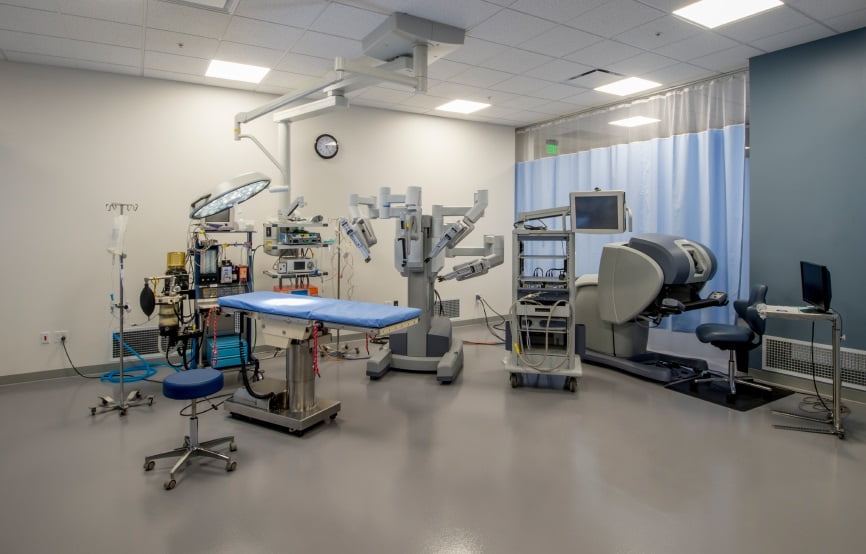Robot Assisted Laparoscopic Prostatectomy (RALP)
What is Robot Assisted Laparoscopic Prostatectomy?

Robot-Assisted Laparoscopic Prostatectomy (RALP) is a type of surgery often used to treat men with prostate cancer.
Surgical removal of the prostate gland (and some of the tissue around it) is one of the treatment options for early-stage prostate cancer. With the prostate gland just below the urinary bladder and surrounded by important nerves for sexual function, removal requires great care to maximize the chance for a cure and maintain continence and sexual function.
This operation may be done by open surgery or by less invasive laparoscopic surgery, which entails small incisions in the abdomen. A lighted viewing instrument called a laparoscope is inserted into one of the incisions while the surgeon uses instruments to reach and remove the prostate through the other incisions. In RALP, robotic arms translate the surgeon’s hand motions into finer and more precise action.
The da Vinci System
The da Vinci surgical system gives your surgeon an advanced set of instruments to use in performing robotic-assisted minimally invasive surgery. The term “robotic” often misleads people. Robots don’t perform surgery. Your surgeon performs surgery with da Vinci by using instruments that he or she guides via a console. The da Vinci System, utilized by Z Urology, allows the doctor to operate with enhanced vision, precision, dexterity, and control.
The da Vinci system translates your surgeon’s hand movements at the console in real-time, bending and rotating the instruments while performing the procedure. The tiny wristed instruments move like a human hand, but with a greater range of motion. The da Vinci vision system also delivers highly magnified, 3D high-definition views of the surgical area. The instrument size makes it possible for surgeons to operate through one or a few small incisions.
Advantages of RALP over traditional open surgery include:
- Smaller incisions
- More precise removal of cancerous areas
- Less post-operative pain
- Reduced blood loss
- Quicker recovery and return to normal activities
- Lower risk of transfusions
Advantages of da Vinci technology compared to traditional laparoscopy:
- More patients return to pre-surgery erectile function at the 12-month checkup
- Faster return of urinary continence
- Lower risk of complications
- Less blood loss and need for a transfusion
- Less chance of nerve injury
- Less chance of injuring the rectum
- Shorter operation
- Less risk of deep vein thrombosis (a life-threatening condition where a blood clot forms deep in the body)
- Shorter hospital stay
- Less chance of hospital readmission or needing follow-up surgery
Who is a candidate for RALP?
Most men with prostate cancer are potential candidates for RALP. Patients must be able to tolerate general anesthesia for 3-4 hours, so those with serious breathing problems are not good candidates. Also, men who have very large prostates or who have had multiple abdominal surgeries may be better suited to open surgery.
Risks of RALP
As with any major surgery done under general anesthesia, there is a certain amount of risk, including heart attack, stroke, and death. Preoperative assessment of a patient’s overall health is part of the surgical workup at UC Davis. Prostatectomies, including those done with a robotic-assisted surgery system, are also associated with the risks of impotence and incontinence.
Sexual Function after RALP
Return of normal erectile function depends on many physical and psychological factors, including the type of prostatectomy (unilateral or bilateral; nerve-sparing or non-nerve sparing, etc.). The function may return from one week to one year after surgery, It typically takes several months. A program of “penile rehabilitation,” using medications such as Viagra or Muse, is recommended as part of the process to facilitate healing and return of erectile function. Additional factors that can affect erectile function include hypertension, diabetes, obesity, atherosclerosis, smoking, and anxiety.
Recovery from RALP
Patients typically experience significantly less pain and less blood loss than those undergoing conventional “open incision” procedures. Patients also tend to enjoy quicker recovery times. A traditional, open radical prostatectomy requires two days of hospitalization and recovery lasting about 2 months. With robotic-assisted surgery, the recovery time is as little as 2-3 weeks. Depending on age and health, most patients can also expect to have their potency return with or without the use of oral medications.
Care After RALP
As with any case of cancer, monitoring for recurrence is crucial. Patients may or may not need additional cancer treatments, depending on the pathology report following surgery. Your physician will develop a post-operative action plan for you, which would likely include periodic measurement of blood PSA, which is still considered the best indicator of cancer recurrence.

